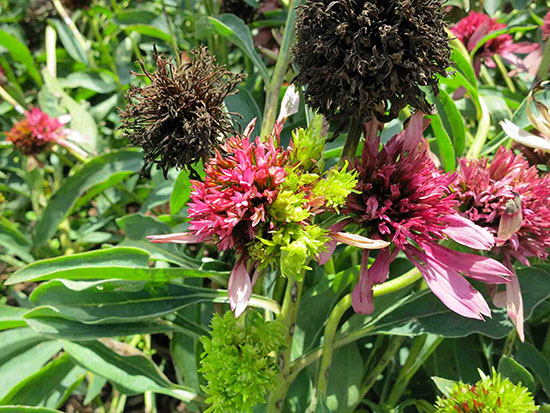Issue 13, August 3, 2015
Aster Yellows
Aster Yellows is a disease commonly found on members of the Asteraceae (Compositae) family, including Aster, Chrysanthemum, marigold (Tagetes), Zinnia and coneflowers (Echinacea). However, you can find the disease on other plants such as carrots and onions.
Plants appear stunted and slightly yellow, but more importantly, the flowers are distorted, possibly highly branched, elongated and/or crested, commonly with green instead of brightly colored petals. Often, growers will think their plants have mutated or have been damaged with a growth-regulator chemical such as a herbicide. With the proliferation of new coneflower cultivars in a multitude of colors in a low-maintenance landscape, Aster Yellows has become more common.

Aster yellows symptoms on Echinacea blossoms.
While Aster Yellows appears virus-like, it's really caused by a phytoplasma. The disease isn't spread by spores like fungi or bacteria; instead the disease is spread by leafhoppers, a sucking insect which moves the disease from plant to plant. The insects, and by extension the disease, is more severe with cool wet weather than hot, dry conditions. As temperatures rise and rainfall or irrigation is minimal, leafhoppers aren't as active.
Unfortunately at the moment, we can't culture Aster Yellows at the UI Plant Clinic.
The best course of action is rogueing out the diseased plants and burying, actively composting, or discarding the plants in the trash. Simply deadheading the suspected flowers will not prevent its spread.
Weed control near planting beds is also recommended as the leafhoppers may feed on many weeds such as dandelions (a member of the Aster family) and plantain as they migrate from the south to the Midwest in early spring.
Spraying leafhoppers regularly with a recommended insecticide may be beneficial in a commercial planting. Buying disease-free stock is also recommended. (David Robson)
Author:
David Robson